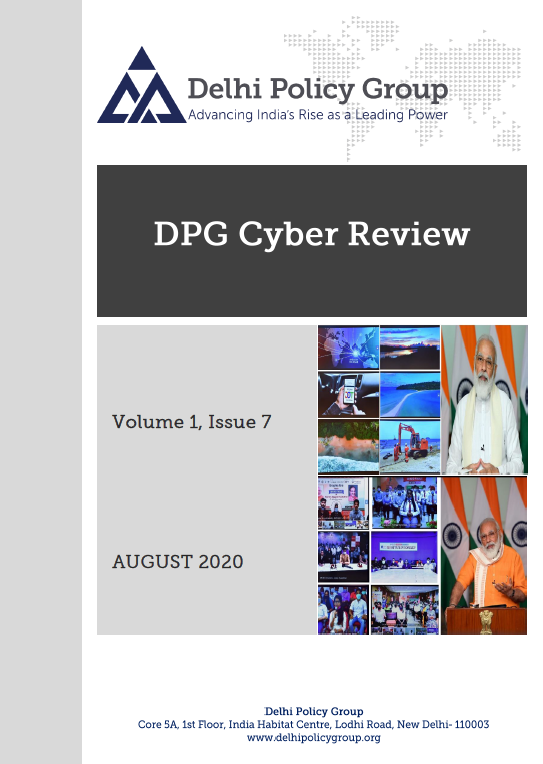Volume 1, Issue 7
Date: September 04, 2020
During August, Indian cyber space was the target of attack, mostly from intelligence agencies of China and Pakistan. However, some attacks also originated from Taiwan, Hongkong and Iran.
With the opening up of the space sector for private participation, Indian private space company, “Skyroot”, successfully launched an upper stage rocket engine on August 12, 2020 and announced plans to launch its first small satellite launch vehicle (SSLV) by December, 2021.
In keeping with the priority attached by the Indian Government to connectivity in remote and border areas of strategic importance, a 2300 km long submarine optical fibre cable between Chennai and the Andaman & Nicobar Islands was inaugurated by the Prime Minister. Projects to provide mobile connectivity to border villages in J&K and Ladakh are also under implementation.
In the midst of the continuing border standoff in Ladakh, China has started laying fibre optic cables and installing other equipment for 5G communications along the Line of Actual Control (LAC).
Indian 5G trials are likely to commence in September, 2020. However, Chinese 5G equipment vendors may be restricted from these trials and auctions on grounds of national security.
Industry bodies like NASSCOM, CII and academic institutions like IITs and IISc are teaming up with the Government organisations for growth of Artificial Intelligence (AI) in India. It is estimated that AI and data could add $450-$500 billion to India’s GDP by 2025. Quantum computing and technology adaptation are also gaining pace and a national Quantum Plan will be ready soon. Blockchain technologies are being explored by the Election Commission to enable remote voting, minimise election tampering and maximise poll accessibility.
India will soon introduce a new Cyber Security Policy. A draft Health Data Management Policy has been released for data privacy protection under the National Digital Health Mission (NDHM). A Computer Emergency Response Team for the Financial Sector (CERT-Fin) to secure the country’s financial sector from cyber attacks is in the offing.
The announcement of a ban on certain items of defence imports has offered new opportunities for major IT companies and start ups which have thus far played a limited role in the development of digital technologies for the Armed Forces. Incentive schemes for local manufacturing of electronic components and semiconductors are also showing results.
During August, the international cyber space has come under attack both from crime mafias and malign state actors. The New Zealand stock exchange became non- operational due to one such cyber-attack.
An intensifying US-China technology Cold War during the month saw China adopting its own brand of “self-reliant” economic strategy. Huawei launched a semiconductor chip production line completely delinked from US technology. Huawei’s smart car solutions business unit plans to launch 100 and 200-channel low-cost multichannel Light Detection and Ranging (lidar) sensors soon. Chinese Video App TikTok has filed a lawsuit challenging the US government's ban of TikTok in the US.
The White House has approved the transfer of 100 megahertz of electromagnetic spectrum from military use to commercial 5G.The US Federal Communications Commission (FCC) has approved 'Project Kuiper’ of Amazon to launch and operate a constellation of 3,236 internet-providing satellites.
A number of bilateral cooperation arrangements on cyber security, data protection and 5G networks have been brought into operation during the month to protect national assets and individual privacy “from aggressive intrusions“ by malign state actors.
China has proposed setting up a BRICS innovation base to strengthen cooperation among the five-country bloc which includes India in sectors like 5G, AI and digital economy.
With the opening up of the space sector for private participation, Indian private space company, “Skyroot”, successfully launched an upper stage rocket engine on August 12, 2020 and announced plans to launch its first small satellite launch vehicle (SSLV) by December, 2021.
In keeping with the priority attached by the Indian Government to connectivity in remote and border areas of strategic importance, a 2300 km long submarine optical fibre cable between Chennai and the Andaman & Nicobar Islands was inaugurated by the Prime Minister. Projects to provide mobile connectivity to border villages in J&K and Ladakh are also under implementation.
In the midst of the continuing border standoff in Ladakh, China has started laying fibre optic cables and installing other equipment for 5G communications along the Line of Actual Control (LAC).
Indian 5G trials are likely to commence in September, 2020. However, Chinese 5G equipment vendors may be restricted from these trials and auctions on grounds of national security.
Industry bodies like NASSCOM, CII and academic institutions like IITs and IISc are teaming up with the Government organisations for growth of Artificial Intelligence (AI) in India. It is estimated that AI and data could add $450-$500 billion to India’s GDP by 2025. Quantum computing and technology adaptation are also gaining pace and a national Quantum Plan will be ready soon. Blockchain technologies are being explored by the Election Commission to enable remote voting, minimise election tampering and maximise poll accessibility.
India will soon introduce a new Cyber Security Policy. A draft Health Data Management Policy has been released for data privacy protection under the National Digital Health Mission (NDHM). A Computer Emergency Response Team for the Financial Sector (CERT-Fin) to secure the country’s financial sector from cyber attacks is in the offing.
The announcement of a ban on certain items of defence imports has offered new opportunities for major IT companies and start ups which have thus far played a limited role in the development of digital technologies for the Armed Forces. Incentive schemes for local manufacturing of electronic components and semiconductors are also showing results.
During August, the international cyber space has come under attack both from crime mafias and malign state actors. The New Zealand stock exchange became non- operational due to one such cyber-attack.
An intensifying US-China technology Cold War during the month saw China adopting its own brand of “self-reliant” economic strategy. Huawei launched a semiconductor chip production line completely delinked from US technology. Huawei’s smart car solutions business unit plans to launch 100 and 200-channel low-cost multichannel Light Detection and Ranging (lidar) sensors soon. Chinese Video App TikTok has filed a lawsuit challenging the US government's ban of TikTok in the US.
The White House has approved the transfer of 100 megahertz of electromagnetic spectrum from military use to commercial 5G.The US Federal Communications Commission (FCC) has approved 'Project Kuiper’ of Amazon to launch and operate a constellation of 3,236 internet-providing satellites.
A number of bilateral cooperation arrangements on cyber security, data protection and 5G networks have been brought into operation during the month to protect national assets and individual privacy “from aggressive intrusions“ by malign state actors.
China has proposed setting up a BRICS innovation base to strengthen cooperation among the five-country bloc which includes India in sectors like 5G, AI and digital economy.



